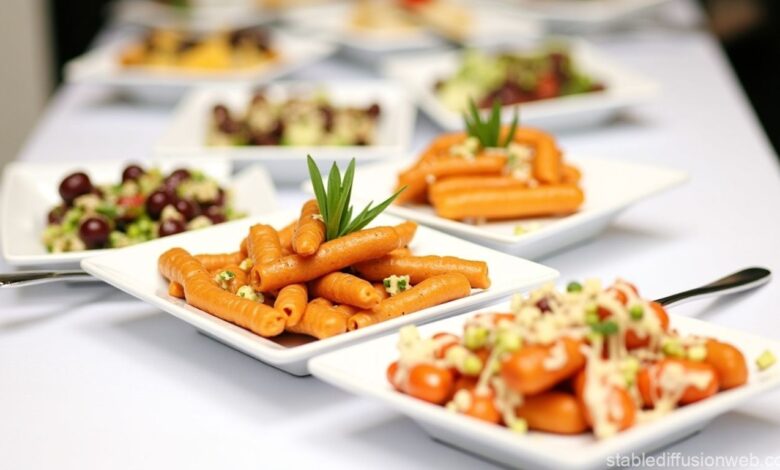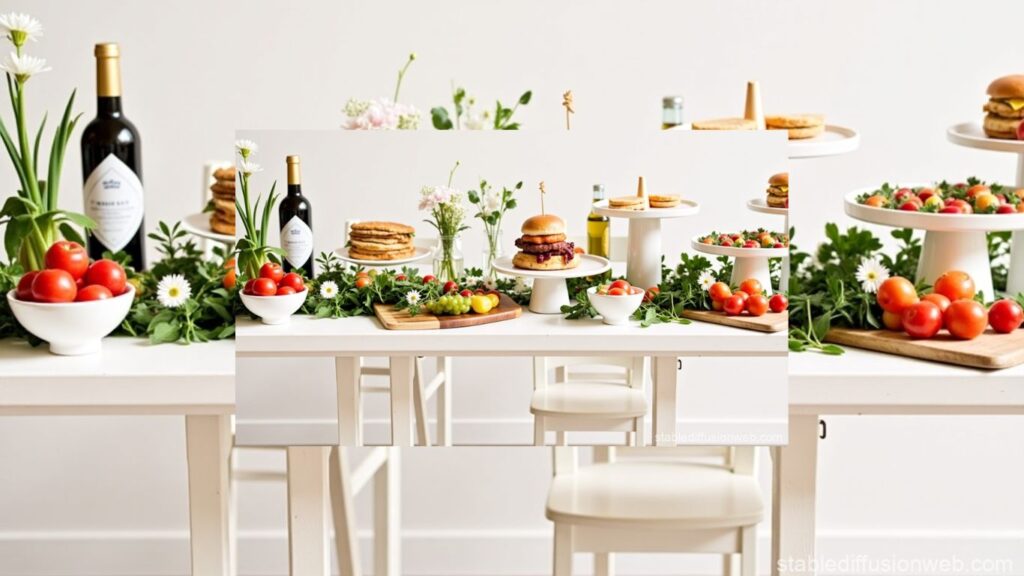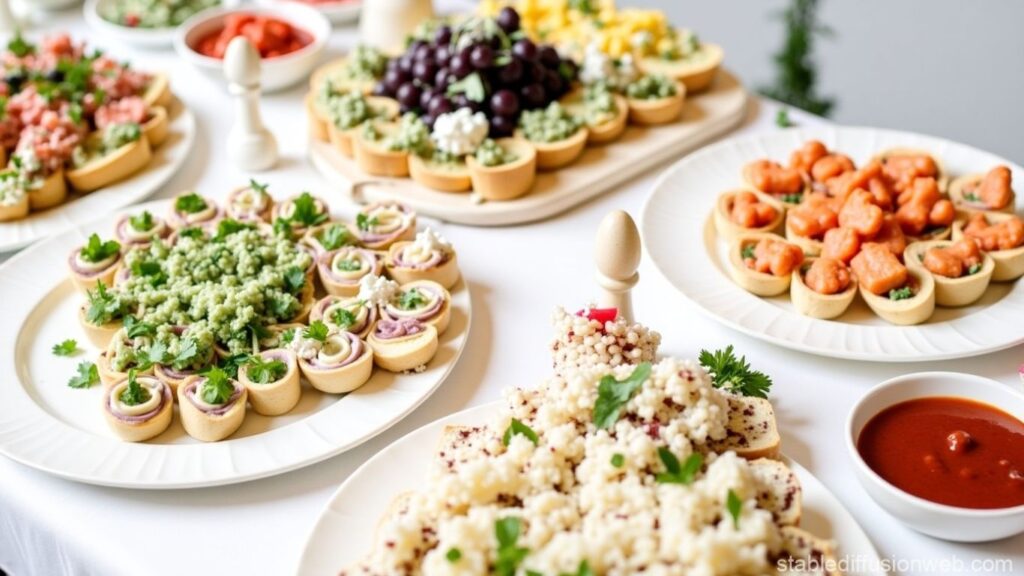The Ultimate Guide to Creating a Stunning Grazing Table: These 7 Grazing Table Themes Will Elevate Any Event

What Is a Grazing Table?
A grazing table is a visually impressive food display that encourages guests to graze, socialize, and explore a wide range of flavors at their own pace. Think of it as a grand, immersive version of a charcuterie board — one that turns the art of snacking into an unforgettable experience. Whether it’s for a wedding, a birthday party, a baby shower, or even a corporate gathering, grazing tables add a creative and elegant flair that feels indulgent yet casual.
The beauty of a grazing table lies not just in the food but in the presentation. Carefully curated ingredients are artfully arranged to evoke abundance, color, and texture. These tables often feature cheeses, meats, fruits, nuts, dips, sweets, and various breads, layered and styled with a designer’s eye.
What Should Be on a Grazing Table?

The best grazing tables strike a thoughtful balance of taste, texture, and visual appeal. Here are the foundational elements to consider when assembling your spread:
- Cheeses: Offer a mix of soft, hard, aged, and fresh cheeses, such as brie, gouda, cheddar, blue cheese, and herbed goat cheese.
- Cured Meats: Popular choices include salami, prosciutto, capicola, and spicy chorizo.
- Fruits: Fresh fruits like grapes, berries, apples, and figs add juiciness and color, while dried fruits such as apricots and dates bring sweetness and depth.
- Crackers & Breads: Use an assortment of textures — thin crisps, whole grain crackers, baguette slices, and breadsticks.
- Dips & Spreads: Elevate flavor with hummus, tzatziki, whipped feta, olive tapenade, or spicy pesto.
- Nuts & Olives: Almonds, cashews, pistachios, marinated olives, and pickles provide salt and crunch.
- Sweet Accents: Add chocolate truffles, honeycomb, macarons, or mini tarts to please those with a sweet tooth.
Don’t forget garnishes! Fresh rosemary sprigs, mint leaves, edible flowers, or even citrus slices can take the look of your grazing table to the next level.
Benefits of a Grazing Table
There’s a reason grazing tables have exploded in popularity at all kinds of events. Here are just a few of the many benefits they offer:
- Visual Appeal: Grazing tables double as edible art. They serve as focal points and conversation starters.
- Flexible Sizing: Whether you’re hosting 10 people or 100, grazing tables scale beautifully to fit the space and guest list.
- Easy Customization: They can be adapted to suit dietary restrictions — vegetarian, vegan, gluten-free, or keto-friendly options are easy to include.
- No Fuss Service: With no need for formal plating or waitstaff, guests can help themselves, making it stress-free for hosts.
- Interactive Experience: Grazing tables encourage exploration, tasting, and social interaction — perfect for laid-back yet elegant gatherings.
7 Grazing Table Themes That Will Elevate Any Event

1. Rustic Country Charm
Embrace the warmth and coziness of the countryside. Use wooden boards, burlap runners, and antique-style platters. Incorporate homemade jams, crusty breads, and locally sourced cheeses and charcuterie. Finish the look with wildflowers and mason jars for that pastoral charm.
2. Boho Luxe
For a trendy, Instagram-worthy vibe, go for a Bohemian-inspired setup. Think layered textures: macrame table runners, gold utensils, and soft linen napkins. Use tropical fruits like dragon fruit or passionfruit, and complement them with gourmet cheeses and truffle-infused meats. Add pampas grass and candles for a dreamy ambiance.
3. Garden Fresh
Celebrate nature’s bounty with a grazing table full of colorful vegetables, garden herbs, and edible flowers. Include rainbow carrots, snap peas, radishes, and cherry tomatoes alongside refreshing dips like dill yogurt or avocado crema. Garnish with mint and basil leaves to reinforce the fresh theme.
4. Seasonal Celebration
Let the time of year guide your menu. In fall, use pumpkins, roasted squash, cinnamon-roasted nuts, and apple slices. In spring, go for berries, pea shoots, fresh cheese, and lemon-infused spreads. A seasonal table connects guests to the moment and often makes use of fresh, local produce.
5. Coastal Mediterranean
Bring the flavors of southern Europe to your event with olives, feta, marinated artichokes, sun-dried tomatoes, and grilled shrimp skewers. Serve with warm pita, hummus, and tzatziki. Decorate the table with olive branches and soft blue tones to evoke a beachside feel.
6. Sweet & Savory Fusion
Perfect for dessert hour or cocktail events, this theme mixes sweet and salty delights. Combine aged cheddar with chocolate-covered pretzels, brie with honey, and prosciutto-wrapped melon. Add nuts, dried fruit, toffee, and mini pastries for an indulgent contrast.
7. Minimalist Elegance
Sleek and sophisticated, this theme focuses on monochrome tones and refined selections. Think black grapes, white cheeses, and charcoal crackers displayed on marble slabs. Use geometric shapes in the layout, minimal greenery, and subtle lighting to maintain a clean, high-end feel.
Pro Tips on How to Do a Graze Table
Even the most beautiful ingredients need thoughtful styling. Here’s how to bring your grazing table to life like a pro:
- Start with Structure: Use risers, boxes, or stands to create multiple levels. This adds visual interest and makes the spread feel more dynamic.
- Build from Big to Small: Place cheeses, breads, and bowls first. Then fill in the spaces with fruits, nuts, and smaller items.
- Keep It Balanced: Distribute colors and textures evenly across the table. If you place red berries on one side, balance them with beets or tomatoes on the other.
- Line the Table: Use butcher paper or parchment for easy cleanup and a cohesive look.
- Garnish Generously: Fresh herbs, florals, and even mini lights can transform the setup from simple to stunning.
Grazing Table vs. Buffet: What’s the Difference?

Although both are self-serve options, grazing tables and buffets are not the same. A buffet typically serves full portions of meals, often in chafing dishes and with a more practical presentation. A grazing table, however, is all about artful abundance — meant to be savored over time with a variety of bite-sized items that blend aesthetics and taste.
Buffets are functional. Grazing tables are an experience.
FAQs About Grazing Tables
What is another name for a grazing table?
Grazing station, food table, or charcuterie spread.
How to do a graze table?
Plan your menu, use parchment paper, build height, and balance flavors.
What is the concept of grazing?
Grazing refers to the act of eating small amounts continuously — a casual, social dining style.
What are the benefits of a grazing table?
It encourages mingling, suits all diets, and serves as a decorative feature.
What is an example of grazing?
Snacking on fruit, cheese, and crackers at an event without a structured meal.
What’s the difference between a grazing table and a buffet?
Buffets are structured meals; grazing tables are casual and decorative.
What is a graze also known as?
Nosh, nibble, snack.
Is a grazing table an appetizer?
Yes, it can serve as an appetizer or the main event, depending on quantity.
Why is it called a grazing platter?
Inspired by animals that graze, it allows people to nibble casually over time.
What do you call a food table?
Grazing table, buffet table, or food station.
What paper do you use for a grazing table?
Butcher paper or food-safe parchment paper.
What is another name for the table?
Board, station, spread.
What is on a grazing table?
Cheese, meat, fruits, dips, bread, sweets, and garnishes.
What is considered grazing?
Eating small bites over an extended period instead of one large meal.
What is the grazing land called?
Pasture or grassland.
What is grazing instead of meals?
Eating small portions throughout the day without formal meals.
What is a grazing plate?
A smaller version of a grazing table served as an individual portion.
What is cow grazing?
When cows eat grass or forage in fields.
What is a grazing party?
A casual gathering centered around a grazing table or multiple grazing platters.
What is a grazing station?
A designated area with a curated selection of finger foods.
What is a grazing board called?
Charcuterie board or snack platter.
What is a synonym for graze?
Nibble, snack, pick.
What is a glazing table?
A misheard or misspelled term, often meant to say “grazing table.”
Why is it called a grazing table?
It reflects the casual, ongoing way guests enjoy the food, similar to animals grazing.
What is in a grazing table?
A diverse spread of meats, cheeses, fruits, veggies, nuts, sweets, and dips.
What to have on a grazing table?
Include a mix of savory, sweet, fresh, and crunchy items.
What is the difference between a grazing table and a charcuterie board?
A grazing table is larger and more elaborate; a charcuterie board is a compact version.
What word class is graze?
Verb and noun.
What is a grazing grassland called?
Pasture, meadow, or range.
What is a dressing table also called?
Vanity table (not related to grazing).
What are grazing animals also known as?
Herbivores or browsers.
What is grazing on dishes?
Taking small bites of various foods.
What is the synonym of graze?
Nibble, snack.
What is a grazing board?
A board featuring a curated selection of meats, cheeses, and accompaniments.
What does it mean when animals graze?
They eat grass and vegetation continuously.
What is a graze table?
Another term for a grazing table — a beautifully arranged food display.
What is the other meaning of grazing?
Injury caused by scraping the skin or continuous light eating.
Are grazing tables safe?
Yes, if properly managed with food safety practices.
What is the best greenery for a grazing table?
Rosemary, thyme, eucalyptus, and edible flowers.
What is the function of grazing?
To feed continuously, often used for both animals and casual human eating styles.
What is the main method of grazing?
Free-range or rotational grazing for animals; casual snacking for people.
How to make a grazing box?
Use a box or tray, fill it with meats, cheeses, crackers, fruits, and sweets.
How to fill a grazing table?
Start with large items, add medium, and finish with small fillers and garnishes.
How to make a salami flower?
Fold thin salami slices over a small glass or wine glass rim and layer in a circular pattern.
Are grazing tables a good idea?
Absolutely! They’re trendy, practical, and visually stunning.
What size plates for a grazing table?
Small appetizer or dessert plates are ideal.
What paper is best for a grazing table?
Food-safe parchment or butcher paper.
What to buy for a grazing table?
Cheeses, meats, dips, fruits, bread, crackers, sweets, garnishes, and decor.
How much cheese do I need for 50 people?
Roughly 12 to 15 pounds, depending on the rest of the spread.
Who invented grazing tables?
There’s no single inventor; the concept evolved from charcuterie boards and Mediterranean meze traditions.
Conclusion
The grazing table isn’t just a food trend — it’s an experience. Whether you’re hosting a rustic wedding or a chic brunch, a grazing table delivers elegance, variety, and flavor in every bite. With thoughtful planning and creative styling, your grazing table will not only satisfy appetites but also steal the spotlight. It’s more than a table — it’s a celebration on a plate.
SEE MORE INFORMATION CLICK HERE Buzznewsdaily




